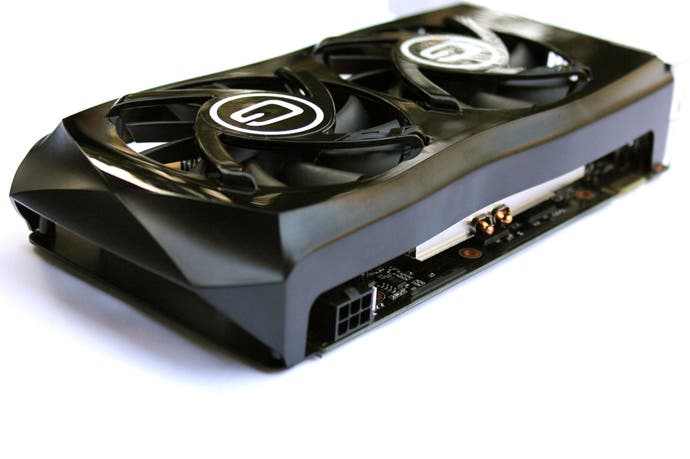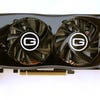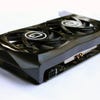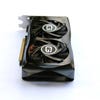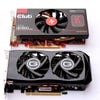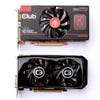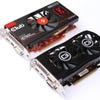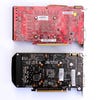Nvidia GeForce GTX 650 Ti Boost review
A sweetspot in price vs. graphical performance?
While it's hard to ignore the big splash made by Nvidia's galumphing GeForce Titan, sales for such a high-spec card are inevitably made from only a fraction of the market. It makes for a spectacular showcase, but in reality the big money for these tech giants is elsewhere - specifically in nailing the absolute best performance-per-pound in popular games where an ideal price-tag for most GPU buyers remains within the £100-200 range. AMD thrives on its strong-hold over this bracket in particular, where the well-received HD 7850 currently retails for just £125, with the just-released 7790 model primed to strengthen this position in this sector at an even lower cost.
The issue for Nvidia is the massive gap this leaves in its Kepler range, with the GTX 650 Ti and the 660 holding ground at £100 and £155 respectively. As a swift rebuttal, the GTX 650 Ti Boost sets out to fill that gap with a launch price of just under £145. However, considering this is hardly a direct price-match for AMD's output, and given that it's only a tenner less than the company's own GTX 660, does this actually represent good value for money right now?
Before we start, we must address the meaning of the "Boost" suffix. As a release it's an anomaly in the Kepler range, which over the last year eroded away the specs and features from the initial GTX 680 standard to suit lower and lower prices. Simply put, the GTX 650 Ti Boost reverts some of the cut-backs made for last year's 650 Ti. It brings back a fully-fledged GPU Boost mode, allowing the card's core clock to dynamically shift according to graphical demands of each application. The feature improves the performance of the card where there's an overhead in its maximum thermal design power (TDP), while also saving on power draw during idle states.
We also see the return of SLI support, though this is limited to a maximum of two GPUs rather than three - not a bother for most motherboard configurations which might match its price-tag. This makes it the cheapest SLI-compatible card in the current range.
"The GTX 650 Ti Boost is a welcome product, addressing the gaping hole in the Kepler line-up between the GTX 650 and its more impressive 660 counterpart."
There are other improvements over the standard GTX 650 Ti too. The rendering output unit (ROP) count takes a jump from 16 to 24, and core clocks go from 928MHz to 980MHz. Meanwhile, memory bandwidth benefits from a widening of the 128-bit bus to 192-bit - an important move for games running at higher resolutions. We also spot speeds going up for its attached 2GB of GDDR5 RAM, now clocked to 6GHz rather than the 5.4GHz of the cheaper card. It's a full-on improvement when taken from this angle, and is advertised to offer up to a 40 per cent advance in performance. The only downsides are the lengthening of the PCB itself, going from a convenient 14.5cm up to 24cm, and a bump up to a max TDP of 134.
There's another slant to this though: the comparison with the 660. It turns out that the face-off here is much simpler, and perhaps more revealing of the card's true origins. What we're seeing is the same PCB size and length, with each card's GK106 chip delivering identical core clocks - plus a matching boost up to 1033MHz.
So, rather than being an augmented 650 Ti at heart, it's much easier to describe this Boost edition as a 660 with a few cutbacks. The crux of it is that we're getting identical stats in every regard to this older card, with one of the big exceptions being the drop from 960 stream processors to 768 - accounting for one of the five SMX chips being chopped. The knock-on effect of this is a drop in the Boost's texture fill-rate from 78.4 Gigatexels per second down to 62.7. This detail comes to bear in our tests quite vividly, especially when running games at maximum settings at full 1080p.
"The name may suggest an upgraded GTX 650 Ti, but the reality is that the Boost has much more in common with the superior GeForce GTX 660."
In terms of design specification it's once again close to the 660, save for Gainward's custom twin 75mm fan solution. This is a dual-slot unit that relies on a single 6-pin PCIe power connector, with support for up to four monitors across DVI-I, DVI-D, HDMI v1.3 and DisplayPort connections. This wasn't possible on our reference 650 Ti, limited as it in terms of port selections by being a single slot card.
The cooling system on the Boost is discrete, and gives us a consistent temperature of 29 degrees Celsius while idling, while playing visually demanding games such as Crysis 3 for an hour raises the heat to 70 degrees. This is slightly higher than the norm, but sits at that point comfortably without showing a need to ramp the fan speeds up to hasten airflow. Compared to the veteran HD 6870 or the more powerful GTX 670, which can produce a faint whirr, the sound signature of the card doesn't audibly change according to load - a positive sign as we now head into our gamut of tests.
Gameplay Analysis: Kepler mid-range tested
Positioned dead-centre in the Kepler mid-range, the 650 Ti Boost aims to tackle the most technically demanding games of 2013 at full 1920x1080 - 1080p. This has widely become the standard resolution to shoot for due to the prevalence of cheaper LCDs, even including IPS models. We resolve to use this resolution across all tests, while finding the ideal graphical preset in each game in a bid to hit 60FPS. We plant the card in our Core i5-2500k test rig, clocked to 4.2GHz and coupled with 8GB 1600MHz DDR3 RAM. Drivers are also fully up-to date as of writing, with version 314.22 purporting to offer performance boosts up to 60 per cent in Tomb Raider.
To start off, we pit the Boost edition of the 650 Ti against the HD 7850 1GB edition, with Crysis 3's high calibre of visual effects and DirectX 11 features putting strains on each. The game scales well thanks to its flexible graphical presets, and in the end, we find the medium setting offers the most reasonable grade of performance without sacrificing the game's visual flair. Alas, the post-processing and particle effects seen on its high setting drag the frame-rate down to 25FPS during the rainy Post-Human stage, which forces a compromise. On medium we manage to hit 60FPS quite comfortably even with textures held on high, and FXAA added. While drops to 40FPS are possible on each card, in the final count performance shows a clear favour for the 650 Ti Boost's Kepler architecture during shoot-outs.
Water effects appear to give the game the most trouble during jungle battles, and we notice a visible trade-off in alpha animations during an early cut-scene with Psycho. This results in a lowered frame-rate on smoke effects as explosions fire off in the distance. Even so, the 650 Ti Boost acquits itself nicely here, while the lowest settings remove all hiccups from play entirely. It's surprising to find that the original 650 Ti holds up at this medium level too with its 1GB of lower-bandwidth GDDR5. Though it can't come close to performance of Nvidia's latest card, Crysis 3 still flows at above 30FPS on this setting. Put a frame-limit cap in place and even this £99 offering still provides a really decent experience that easily outstrips current-gen console.
"Crysis 3 is the closest thing we have to a 'next-gen' game at the moment and the Ti Boost produces some decent results between 50 to 60FPS at medium settings."
Alternative analyses:
- GeForce GTX 650 Ti Boost 2GB vs GeForce GTX 650 Ti 1GB
- GeForce GTX 650 Ti Boost 2GB vs. GeForce GTX 660 2GB (ultra settings, Crysis 2 in place of Crysis 3)
Though Crytek's new shooter ranks among the most demanding games on our test palette at the moment, DICE's Battlefield 3 still gives each card a good run for its money. The high graphical preset is within reach for this one, which by default is coupled with post-process AA, screen-space ambient occlusion and motion blur effects. The parking lot shoot-out on the Operation Swordbreaker stage may lack the grander scale environments promised in Battlefield 4's Fishing in Baku trailer, but it does a good job of highlighting what we can expect in performance terms from the updated Frostbite Engine 3 once the game launches this year.
Destruction physics and DirectX 11 effects come as standard in this package, giving the 7850 and original 650 Ti difficulties holding on to a solid 60FPS. However, the 650 Ti Boost Edition, comes closer to the performance standards of the 660, with much of the game on high settings flat-lining at the top of our graphs. To distinguish the two a little better, we run Battlefield 3, Crysis 2 and The Elder Scrolls: Skyrim at maximum settings instead, which in Battlefield's case means rolling out 4x MSAA. The results are illuminating: the 650 Ti Boost trails behind the 660 at every turn, often by a matter of 10FPS in Crysis 2, and with a difference of up to 8FPS for the likes Battlefield 3 and Skyrim.
The contrast in performance between the 650 Ti Boost and 660 is staggering given the current £10 divide between the two cards. For the money, the 20 per cent drop in stream processors on the Boost has a clear impact on compute tasks for more complex games. Though a compromise is clearly possible on lower settings, these results do reflect how the Boost version copes once more next-generation titles translate to PC in the future, and how the 660 will adapt with greater ease.
To get an idea of how the 650 Ti Boost performs in other newer titles, we compile a sequence of in-engine benchmarks for games such as Bioshock Infinite, Tomb Raider and Hitman: Absolution. It's satisfying to see that we can challenge the card with high settings for each, plus 2x MSAA where applicable, and for the average results to often come out at over 60FPS.
Bearing in mind the pricepoints, we would have preferred to have included the 2GB version of the 7850 here, but unfortunately the kit was not available. However, multiple reviews have revealed little to no difference at 1080p resolution - a situation unlikely to change until next-gen console makes its mark, and intense use of GDDR5 comes to the fore. The sticky situation nVidia has is that while the 650 Ti Boost would almost certainly produce the much the same results against the 2GB 7850, the fact is that the 1GB version we tested can be acquired for just £125. However, assuming you're buying the 2GB version of either card in part to future-proof yourself for next-gen titles, the contest turns out to be rather intriguing.
"Running the Ti Boost across many demanding benchmarks, we see accomplished 1080p performance and a pitched battle against the Radeon HD 7850."
Alternative analysis:
Let's tabulate all of those responses and see where we end up.
| GTX 650 Ti Boost 2GB | Radeon HD 7850 1GB | |
|---|---|---|
| BioShock Infinite | 81.9 | 81.5 |
| Hitman Absolution | 41.3 | 46.7 |
| Batman: Arkham City | 98 | 89 |
| Tomb Raider | 67.1 | 69.4 |
| Sleeping Dogs | 49.1 | 56.3 |
| Metro 2033 | 29.4 | 32.6 |
| Crysis | 61.7 | 61.8 |
When compared to the 7850, the only major shortfall on the 650 Ti Boost is with Square Enix titles such as Sleeping Dogs, Hitman: Absolution and Tomb Raider. In each of these cases AMD's card wins out, with the biggest difference being the 56.3FPS average in Sleeping Dogs compared to the Boost's 49.1FPS. Elsewhere, the sheer number of on-screen NPCs in Hitman pulls Nvidia's card down to 41.3FPS overall, while the 7850 manages to achieve a superior 46.7FPS. This may well be a matter of driver optimisation among newer titles, but the lead is surprising, and consistent with our earlier Skyrim tests revealing a clear lead on the 7850.
As expected, Metro 2033's punishing benchmark makes a misery out of the situation for both cards, with 29.4FPS on the 650 Ti Boost coming close to the 32.6FPS offered on the 7850. We opt for 4x MSAA option in this case, and given the level of destruction and lighting effects at play, even these numbers come as something of a pleasant surprise. Obviously, the in-game application of each engine tends to be far less strenuous, so such results still set a good precedent for actual play. It's also encouraging to see games like Batman: Arkham City, Bioshock Infinite, and the notoriously resource-hungry Crysis coming out with over 60FPS on both cards.
To get an impression of where each GPU stands side-by-side, we've updated our FRAPS benchmark tests of older games running on maximum settings, 2x MSAA where possible, no v-sync and at 1080p - opening up the scope of the testing to include alternatives in the Kepler line. Nvidia's GTX 660 once again demonstrates a tangible advantage over the 650 Ti Boost for games like Saint's Row: The Third, where we run through a scripted boss fight with a chopper. In this case, there's a 19 per cent lead on the DirectX 11 setting for the older Nvidia card, while DiRT 3 offers a seven per cent advantage going the same way.
"The latest mid-range Kepler ticks all the performance boxes but its initial launch pricing is uncomfortably close to the next step up - the GeForce GTX 660."
| GTX 650 Ti 1GB | GTX 650 Ti Boost 2GB | GTX 660 2GB | Radeon HD 7850 1GB | |
|---|---|---|---|---|
| Call of Duty: Modern Warfare 3 | 121.7 | 143.9 | 157.4 | 140.6 |
| Diablo 3 | 84.0 | 101.5 | 108.5 | 101.8 |
| DiRT 3 | 66.2 | 89.7 | 109.2 | 96.8 |
| Portal 2 | 159.6 | 202.7 | 240.4 | 198.4 |
| Saints Row: The Third DX11 | 31.9 | 42.1 | 50.2 | 41.5 |
| StarCraft 2 | 70.9 | 86.5 | 86.8 | 75.4 |
Compared to the 7850 - even in its 1GB configuration here - it's more of a mixed bag. The rule of thumb is that the 650 Ti Boost performs marginally better in most cases, save for our 2v2 replay match in StarCraft 2. Curiously, there turned out to be little difference from the 660 average during this test.
Nvidia GeForce GTX 650 Ti Boost: the Digital Foundry verdict
In practise, the gap between the GTX 650 Ti and the 660 proves wide enough to justify the existence of this middle-ground release, the 650 Ti Boost. Calling it an update to the lower-end card is a fallacy, however, as both its price and spec-sheet bear little in common with the original Ti. Make no mistake, this is a stripped down 660 with all its clocks and ROPs in tact. Reprising the Boost mode feature also brings about huge dividends in squeezing the most from each game tested here, with clocks going up to a potential 1072MHz on this Super Sample edition.
Despite being a strong performer in Crysis 3, as a card retailing at £20 more than AMD's HD 7850 it does lack a comprehensive advantage across every game. The biggest take-away however, is that the 660 currently offers better value for money at this moment in time, given that it's had time to settle in the market over the past year. At the lowest current prices from major retailers, we see Gainward's own 660 going for just a tenner more, and with up to a 10FPS advantage in games built around the next generation tech of CryEngine 3 and Frostbite 2.
However, this represents the nature of new GPU releases. The 650 Ti Boost is typical of many cards in its launch window, retailing at a higher price-point than expected and getting too close for comfort to the next-best entry in the company's own range. At £142 it's a little on the dear side, and makes older Kepler releases such as the 660 out to be quite precious in the performance-per-pound metrics. We've been here before with the GTX 660 Ti - ostensibly a cut- down version of the GTX 670 - that needed an extra month for it to distinguish itself with a £20 price-drop. At the time of review, the small amount of extra money required made the 670 the better buy. These days, the 660 Ti offers better value for all but the most demanding of gamers, especially if 1080p resolution is your limit.
We'll be in this situation every time a cut-down "budget-conscious" GPU is released, always eager to capitalise on the initial marketing push. But given a similar price-drop within a likewise time-frame, the GTX 650 Ti Boost's results are clearly strong enough for it to stand apart from the mid-range competition once it's settled. Until then, it's simply the case that there are better-valued alternatives available in both the GTX 660 and HD 7850.
